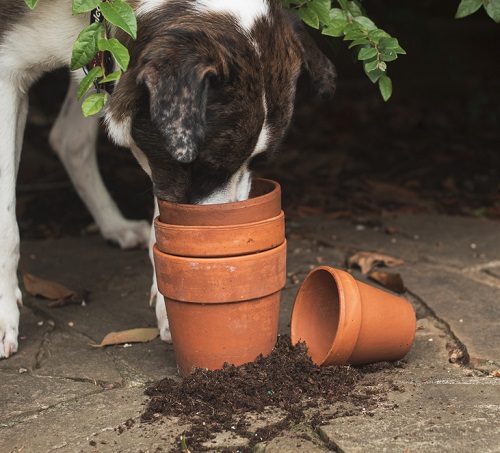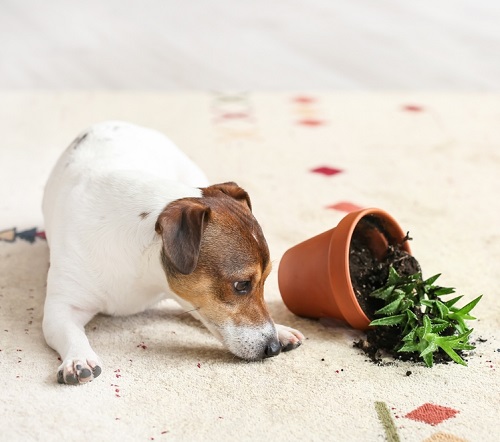My Dog Ate Potting Soil! What Should I Do? If this is something you are worried about, here’s all you need to know!
If you are both a plant and pet parent, there are chances you find your Fido waggling around the pots. Dogs, by nature, find dirt or potting soil enticing and might want to savor them. However, that might not be a gut-friendly act for them. So, let’s learn what immediate steps you must take if your Dog Ate Potting Soil and how you can stop such instances in the future!
What Do You Mean By Dog Ate Potting Soil?

When we say “Dog Ate Potting Soil,” it means that the dog ingested or consumed potting soil. This refers to the act of the dog physically eating or swallowing the soil that is typically used for planting or gardening purposes.
The ingestion of potting soil by dogs can have potential consequences, depending on factors like the content of the soil, quantity ingested, and the individual dog’s health and sensitivity.
Check out Can Dogs Eat Teriyaki Chicken | Is Teriyaki Chicken Bad For Dogs here
Why Do Dogs Eat Potting Soil?
Dogs often tend to eat non-food items such as dirt or potting soil, which might be a result of their natural instincts or underlying medical conditions. Here are the most probable ones:
- Curiosity and Attention Seeking: Dogs are naturally curious animals, and the smell, texture, and taste of potting soil may pique their interest. Also, if eating soil gets your attention (even if it’s negative attention), your dog might continue the behavior.
- Pica: This is a medical issue that drives dogs to eat non-food items. Pica can be caused by numerous factors, including dietary deficiencies, boredom, and even underlying medical issues.
- Predatory Behavior: If your dog is a natural digger or hunter, it may end up eating soil while trying to reach its “prey” or while exploring the smells in the ground.
- Boredom or Lack of Stimulation: Dogs may engage in behaviors like eating potting soil when they are bored or not provided with enough mental and physical stimulation. It can be a way for them to alleviate their boredom and occupy themselves.
- Nutritional Instinct: If your dog’s diet is lacking certain nutrients, they may resort to eating non-food items, like potting soil, in an attempt to supplement their dietary needs. Potting soil can contain minerals or organic materials that attract them.
- Underlying Medical Conditions or Side Effects: Certain medical conditions affecting the brain, like tumors or neurologic disorders, can alter a dog’s behavior and lead to pica. Additionally, gastrointestinal disorders or medicinal side effects might lead to increased appetite or malabsorption of nutrients in dogs that might encourage them to snack on non-food items such as soil.
Is Potting Soil Bad for Dogs—Potential Health Concerns

Potting soil may not be toxic to dogs if it has ingested a small amount or has just slurped the top layer once or twice. Potting soil toxicity majorly depends on its constituents and the quantity ingested. Nevertheless, keeping an eye on your pet and ensuring it does not eat potting soil is a safer taken, as there are certain health concerns associated with Dogs Eating Potting Soil:
- Toxic Substances: Some potting soils may contain additives like fertilizers, pesticides, or chemicals that can be toxic to dogs if ingested in large quantities. These substances can lead to gastrointestinal distress, poisoning, or other adverse reactions.
- Choking Hazards: Potting soil may contain hard objects, such as rocks, eggshells, or debris, that can cause choking hazards or blockages in the digestive tract. This can lead to vomiting, diarrhea, abdominal pain, or even require surgical intervention in severe cases.
- Parasites and Pathogens Potting soil may harbor harmful bacteria, fungi, or parasites that can cause infections or gastrointestinal disturbances when ingested. These can lead to illnesses such as bacterial or fungal overgrowth, gastrointestinal infections, or other related complications.
Find some Homemade Treats for Dogs with Sensitive Stomach here
What is the Role of Pica in Dogs Eating Potting Soil?
Pica is a condition in which animals crave and consume non-food items, ranging from rocks and plastic to clothing and, yes, soil. This behavior can be driven by various factors, such as dietary deficiencies, underlying health issues, and even psychological factors. Dogs with unbalanced diets might eat soil in an attempt to obtain essential nutrients missing from their food.
Certain medical conditions, such as endocrine disorders, can also trigger pica by causing abnormal increases in appetite or alterations in nutrient absorption. Furthermore, psychological distress, including anxiety and boredom, might prompt dogs to engage in unusual behaviors, including pica, as a coping mechanism or a way to stimulate themselves.
While pica can be a standalone behavioral issue, it often signals underlying problems that require attention. Therefore, if a dog persistently tends to eat potting soil, it might be an indication of pica that needs to be immediately addressed by experts to avoid any fatal consequences.
My Dog Ate Potting Soil! What Should I Do?
If your dog has eaten potting soil, here are some measures you can take:
- Assess the Situation: Determine the quantity of potting soil your dog has consumed and whether there were any potentially harmful additives or foreign objects mixed in the soil. This information will be helpful when seeking advice from a veterinarian.
- Monitor your Dog: Watch your dog closely for any signs of distress, such as vomiting, diarrhea, abdominal discomfort, loss of appetite, or unusual behavior. Keep an eye on their bowel movements and overall well-being.
- Contact your Veterinarian: If your dog exhibits concerning symptoms or you are unsure about the safety of the potting soil they consumed, it’s best to contact your veterinarian for guidance. Describe the situation in detail, including the type of potting soil and any additives present. They will advise you on the next steps based on your dog’s specific circumstances.
- Prevent Future Access: Take measures to prevent your dog from accessing potting soil in the future. Store it securely in a location where your dog cannot reach it.
How to Calm Down a Catahoula? Learn here
How to Stop My Dog from Eating Potting Soil in the Future?

- Supervision and Redirection: Keep a close eye on your dog when they are near plants or gardening areas. If you see them showing interest in the potting soil, redirect their attention to an appropriate toy or activity.
- Create Barriers: Use physical barriers or fencing to restrict access to areas with potting soil. You can use baby gates, plant pot covers, or raised garden beds with protective covers to prevent your dog from reaching the soil.
- Positive Reinforcement Training: Train your dog with positive reinforcement techniques to avoid potting soil. Reward them with treats and praise when they ignore or avoid the soil. Teach them commands such as “leave it” or “off” to discourage the behavior.
- Provide Mental and Physical Stimulation: Ensure your dog receives plenty of mental and physical exercise to keep them engaged and reduce boredom. Provide interactive toys, puzzle feeders, and playtime to keep their minds occupied and prevent them from seeking out potting soil out of boredom.
- Use Deterrents: Make the potting soil unappealing to your dog by using safe, dog-friendly deterrents, such as sprays or natural substances that have an unpleasant taste or smell, to discourage ingestion.
- Substitute with Appropriate Chewing Options: Provide your dog with a variety of appropriate chew toys and bones to redirect their chewing and oral fixation. This will satisfy their natural urge to chew without resorting to potting soil.
- Seek Professional Guidance: If the behavior persists or becomes a significant concern, consider consulting with a professional dog trainer or behaviorist.
Quick Takeaways
If your dog has eaten potting soil, it’s important to monitor their behavior and health for any signs of distress. Mild ingestion of potting soil may result in temporary gastrointestinal upset, while larger quantities or ingestion of toxic substances can pose more significant risks. Contacting a veterinarian is advisable if your dog exhibits concerning symptoms or if you suspect toxicity.
Check out Can Dogs Eat Snickerdoodles? here
FAQs
1. Is it Bad for Dogs to Eat Potting Mix?
Ingesting potting mix can have potential health risks for dogs. The specific concerns include possible toxic substances in the mix, gastrointestinal issues, foreign object ingestion, and bacterial or fungal contamination. It’s best to discourage dogs from eating potting mix and seek veterinary advice if ingestion occurs.
2. How Do you Treat Fertilizer Poisoning in Dogs?
If you suspect fertilizer poisoning in your dog, it’s important to seek immediate veterinary assistance. The treatment will depend on the type of fertilizer and the symptoms your dog is experiencing. The veterinarian may induce vomiting, administer activated charcoal to absorb toxins, provide supportive care, and potentially use specific antidotes or therapies based on the situation.
3. What Will Happen if You Ingest Potting Soil?
Ingesting potting soil, particularly in small quantities, is generally not harmful to humans. It may pass through the digestive system without causing significant issues. However, potting soil can carry bacteria, fungi, or parasites that may cause infections if ingested. If you experience symptoms like stomach discomfort, diarrhea, or illness after ingesting potting soil, it’s best to consult a healthcare professional for appropriate advice.
